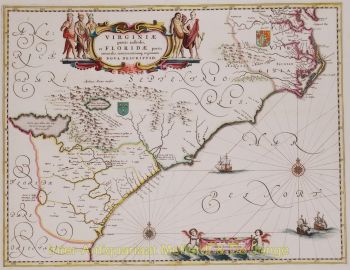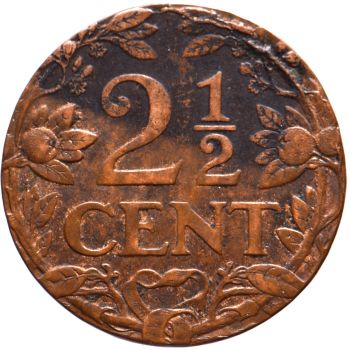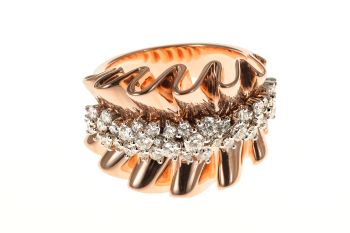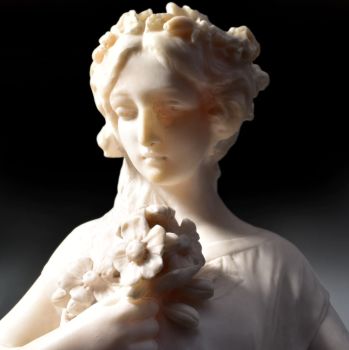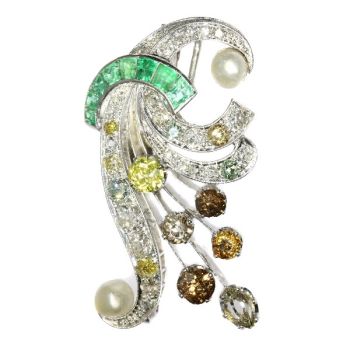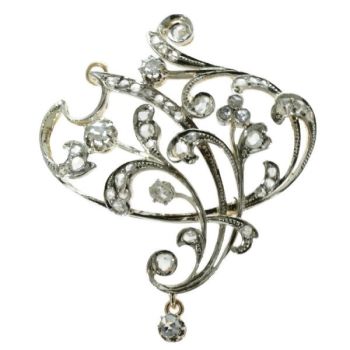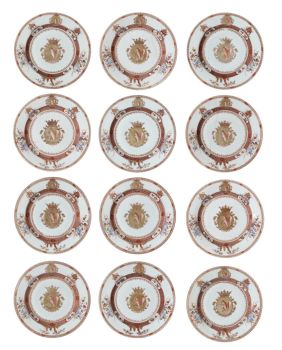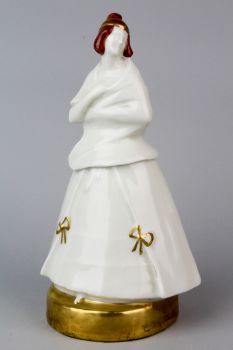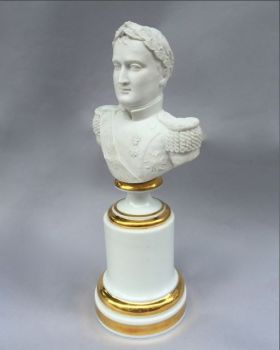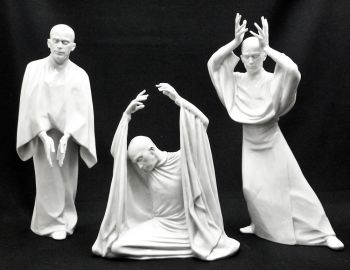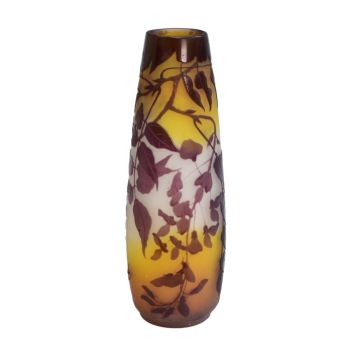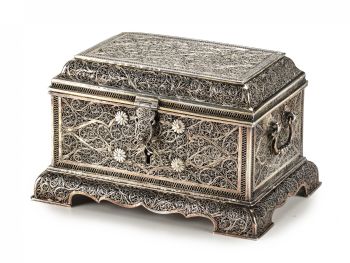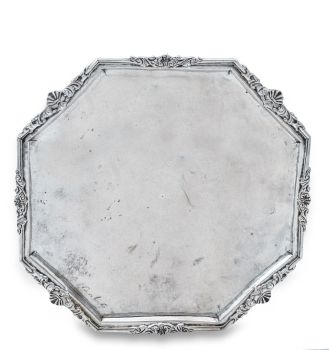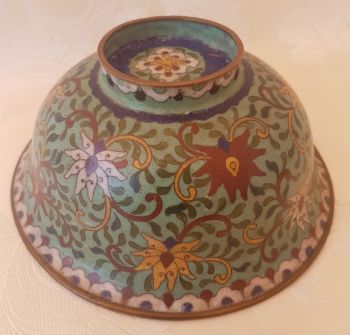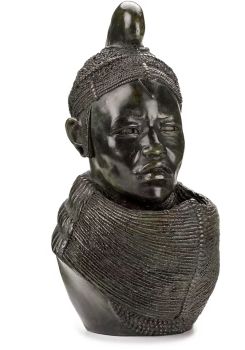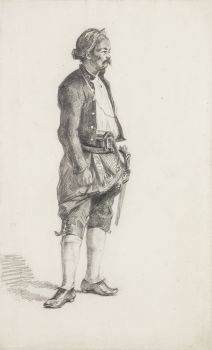UNE GRANDE EXPORTATION ARMORIALE CHINOISE PORCELAINE BLEUE ET BLANCHE 'VAN DER DOES - STEIN VAN GOLL 1755
Artiste Inconnu
PorcelainePorcelaine chinoise
ø 38 cm
Prix sur demande
Zebregs & Röell - Fine Art - Antiques
- Sur l'oeuvre d'artQianlong period, circa 1755
Blue and white porcelain painted with a double coat of arms beneath a crown to the centre, the rim with three peony sprays between bands of diaper pattern, in the centre, two coats-of-arms.
Diam. 38.4 cm
Note:
On the left are those of Van der Does. They had been born this way by ennobled by King William I since the beginning of the 16th century. The arms on the right are those of the (van) Stein van Gollenesse family. Julius (van) Stein van Gollenesse (1691-1755) was the first to bear these arms in Colombo in 1748. His daughter, Anthonia Dorothea, who married Gerard van der Does, bore these arms on a seal of 1766.
This armorial service was made for Gerard van der Does (Gouda 1732 - Batavia 1758) and Anthonia Dorothea (van) Stein van Gollenesse (Batavia 1740 - Zwolle 1774) on the occasion of their marriage in Batavia on 25 July 1755.
Gerard van der Does belongs to an ancient and prominent family, originally from Croisilles (France) but settled in Holland since about 1320. The family owned the manor house Ter Does near Leiderdorp. In the 15th and 16th centuries, members of the Van der Does family belonged to the patriciate of Delft and Leiden. Later branches with several family members occupied prominent positions in Gouda, Dordrecht, Amsterdam, Gorinchem and ‘s Hertogenbosch. In 1815 this branch was ennobled in the Netherlands. Gerard's father, Adriaan (1686-1749), councillor and alderman in Gouda, and his wife Catharina de Grande (1688-1774) married in 1712 and belonged to the wealthiest inhabitants of Gouda. They had ten children of which Gerard was the youngest. Gerard joined the VOC before 1754 as a junior merchant, then became “Tweede in de Groote Winkel” (second shop keeper), merchant and “Eerste Suppoost van het Comptoir-Generaal”. In 1755 he was appointed alderman of Batavia, but his career was a short one, he died three years later. - Sur l'artiste
Il peut arriver qu'un artiste ou un créateur soit inconnu.
Certaines œuvres ne doivent pas être déterminées par qui elles sont faites ou elles sont faites par (un groupe d') artisans. Les exemples sont des statues de l'Antiquité, des meubles, des miroirs ou des signatures qui ne sont pas claires ou lisibles, mais aussi certaines œuvres ne sont pas signées du tout.
Vous pouvez également trouver la description suivante :
•"Attribué à …." A leur avis probablement une oeuvre de l'artiste, au moins en partie
•« Atelier de …. ou « Atelier de » À leur avis, une œuvre exécutée dans l'atelier ou l'atelier de l'artiste, éventuellement sous sa direction
•« Cercle de… ». A leur avis une oeuvre de la période de l'artiste témoignant de son influence, étroitement associée à l'artiste mais pas forcément son élève
•« Style de … ». ou "Suiveur de ...." Selon eux, une œuvre exécutée dans le style de l'artiste mais pas nécessairement par un élève ; peut être contemporain ou presque contemporain
•« Manière de… ». A leur avis une oeuvre dans le style de l'artiste mais d'une date plus tardive
•"Après …." A leur avis une copie (quelle qu'en soit la date) d'une oeuvre de l'artiste
•« Signé… », « Daté… ». ou « Inscrit » À leur avis, l'œuvre a été signée/datée/inscrite par l'artiste. L'ajout d'un point d'interrogation indique un élément de doute
• "Avec signature ….", "Avec date ….", "Avec inscription …." ou "Porte signature/date/inscription" à leur avis la signature/date/inscription a été ajoutée par quelqu'un d'autre que l'artiste
Êtes-vous intéressé par l'achat de cette oeuvre?
Artwork details
Related artworks
Artiste Inconnu
Un rare filigrane un gobelet retortoli1550 - 1600
Prix sur demandePeter Korf de Gidts - Antiquairs
1 - 4 / 12- 1 - 4 / 11
- 1 - 4 / 24
Artiste Inconnu
UN MODÈLE JAPONAIS D'UN NORIMONO, UN PALANQUIN1650 - 1700
Prix sur demandeZebregs & Röell - Fine Art - Antiques
Artiste Inconnu
The bell of the VOC fortress in Jaffna, Sri Lanka1747
Prix sur demandeZebregs & Röell - Fine Art - Antiques
 Sélectionné par
Sélectionné parDanny Bree
 Sélectionné par
Sélectionné parDanny Bree
Artiste Inconnu
UN PLAT EN ARGENT LOBBED INDONÉSIEN INSOLITElate 17th
Prix sur demandeZebregs & Röell - Fine Art - Antiques
Artiste Inconnu
A large Japanese Imari porcelain 'VOC Groningen' dish1800 - 1925
Prix sur demandeZebregs & Röell - Fine Art - Antiques
1 - 4 / 24Artiste Inconnu
Series of 6 Chinese cups and saucers (Yongzheng period)1722 - 1735
Prix sur demandeKuipers Kunst & Antiek
Artiste Inconnu
A large Japanese Imari porcelain 'VOC Groningen' dish1800 - 1925
Prix sur demandeZebregs & Röell - Fine Art - Antiques
1 - 4 / 24Artiste Inconnu
A Surinam-themed Amsterdam long-case clock1746 - 1756
Prix sur demandeZebregs & Röell - Fine Art - Antiques
 Sélectionné par
Sélectionné parGallerease Magazine
Artiste Inconnu
The bell of the VOC fortress in Jaffna, Sri Lanka1747
Prix sur demandeZebregs & Röell - Fine Art - Antiques
 Sélectionné par
Sélectionné parDanny Bree
Artiste Inconnu
Deux portraits d'étude du Mas Marco Kartodikromo1900 - 1950
Prix sur demandeZebregs & Röell - Fine Art - Antiques
Artiste Inconnu
Japanese transition-style lacquer coffer 1640 - 1650
Prix sur demandeZebregs & Röell - Fine Art - Antiques
Artiste Inconnu
A large Japanese Imari porcelain 'VOC Groningen' dish1800 - 1925
Prix sur demandeZebregs & Röell - Fine Art - Antiques
1 - 4 / 12



